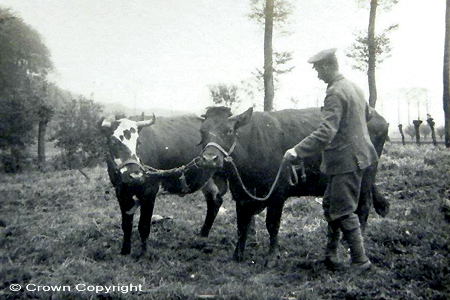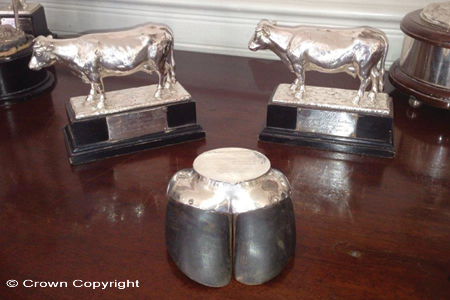|
THE TALE OF BELLA AND BERTHA
by Major Randall Nicol
formerly Scots Guards
|

Bella and Bertha with their second cowman - 1915
|
In the late autumn of 1914 the 7th Division, hurriedly reinforced after the very heavy losses of the First Battle of Ypres, were sent to take over the line south of Armentières. The 20th Brigade, with the 1st Grenadier and 2nd Scots Guards, was responsible for the sector looking towards Rouges Bancs at the foot of the Aubers Ridge, arriving on 15th November. Fromelles, in German hands, lay a little further up the slope of the Ridge opposite. The very early trenches here were in a particularly muddy and ill-drained place, made worse by a stream, the Rivière des Layes, flowing through it from the south, crossing No Man’s Land into the British line at this very spot. The digging of trenches by both sides disturbed such field drainage as there was and physically the conditions were as dire as at any time anywhere on the Western Front. What was still thought to be frostbite quickly made its appearance, but was in reality trench foot. Many succumbed.
The military impasse here had occurred very shortly before and though the inhabitants had left the immediate area, some abandoned farm animals were still there, mostly becoming victims of bullets and shells or being shot and eaten. The likeliest person to have thought of catching two cows in milk for another purpose was Lieutenant Tom Ross, the Scots Guards Quartermaster, though he never took any credit for it.
Sgt Christopher Pilkington, serving with the Artists Rifles, was a professional photographer invited to join accompany the Battalion, presumably, because he and Tom Ross, an enthusiastic amateur photographer, knew each other. The Battalion left The Tower of London in September to join the 7th Division, then forming in the New Forest. They embarked at Southampton for Zeebrugge on 5th October. Sgt Pilkington was with them until shortly before Christmas and his very interesting and high quality photographs from this period are in the Imperial War Museum. His ‘minder’ was LCpl Alexander Mavor from Aberdeen, by the end of the war a Company Sergeant Major and twice awarded the DCM. Sgt Pilkington described how, on 19th November, they both went to the support line where:
The bottom of the trench was a mass of slush and also very slippery. The top and surrounding country white with freezing snow. There was a lot of sniping going on but so far as I could judge no bullets came very near us. After some time we left the trenches with orders to look for a cow. It was rather creepy as the snow showed up our black figures, but we found a herd and selected a cow and brought her back along to furnish milk for the officers’. After another cow was caught and brought to Battalion Headquarters at La Cordonnerie Farm they were christened Bella and Bertha. Lieutenant Alan Swinton wrote that “in no time we had an officially appointed cowman; he was on my payroll, and for the rest of the war the officers had fresh milk.”
The cows went everywhere with the Battalion from then on. Movement by train was straightforward and on longer marches they were shod. Authority took a benign view, though in the last winter of the war the Town Major of Arras tried and failed repeatedly to enforce a regulation banning transport animals from the town, only to meet the unarguable response that Bella and Bertha were not transport animals but the battalion cows.
The officers paid for their upkeep during the winter months and during the rest of the year they grazed. Later it would appear that the Medical Officer had first call on the milk, sent up with the rations even during the darkest days on the Somme and the very harsh winter that followed.
In May 1915, 2nd Lt The Honourable Charlie Mills transferred to the Scots Guards from the Queen’s Own West Kent Yeomanry, and landed the following month in France. He was MP for Uxbridge, the youngest elected in the 1910 General Election and a partner in the family private bank, Glyn, Mills & Co. He was killed by a shell early in October at Loos. Sometime in 1914 a Life Guards officer brought his own car over to France. It was subsequently seized by the military police at Boulogne, where it stayed because there was no available means of sending it back. In August 1915 Lieutenant Mills ‘acquired’ it and brought it to the Battalion, where it was christened Michael and led a most useful if unauthorised career. It resembled and was disguised as an ambulance, though on one occasion, carrying officers in a hurry to get to the leave boat on time, it was pursued by a RAMC colonel in a staff car, incensed that an ambulance was going so fast. The fat was then almost in the fire, but the successful solution was to replace the number plates with those of an Army Headquarters car known to be undergoing long term repairs in St Omer.
At any time either Bella or Bertha would be in milk or in calf. Calves were then bartered on the military black market. One was exchanged for a new set of tyres for Michael and two hundred gallons of petrol and the same calf was subsequently spotted being carried onto a steamer at Boulogne on its way to England. Michael was eventually impounded early in 1918 at Arras.
Nothing more is known of Bella and Bertha’s first cowman from Left Flank, except that he was killed at Neuve Chapelle. There is a photograph, which can only be in the summer of 1915, of the cows with their second cowman, a soldier with a huge, bushy moustache, but exactly who he was remains unknown. In the last two years of the war and for a time afterwards Bella and Bertha were in the care of Private John Slidders of Dundee, an older wartime volunteer and former tram driver, of whom it was written that ‘He was very fond of the cows, and they held the same opinion of him’.
After the Armistice, Bella and Bertha marched with the Battalion to Cologne and in the spring were shipped home as ‘Officers’ Chargers’. On 22nd March 1919 they took part in at least the first stages of the Guards Division’s march through London which, from Wellington Barracks, ranked past King George V and Queen Mary in the forecourt of Buckingham Palace. For a few years they stayed on; at Windsor they were taken to graze in the Great Park and later, in London, where they lived in the Household Cavalry stables at Knightsbridge, they grazed in Hyde Park. All the while, Board of Agriculture officials pestered and puzzled over their smuggled and un-quarantined presence. Eventually, they retired and lived out their lives at Blythswood, Renfrewshire.

Silver figures of Bella and Betha, on loan to the Officers’ Mess,
Queen’s Guard, St James’ Palace
|
|
|


